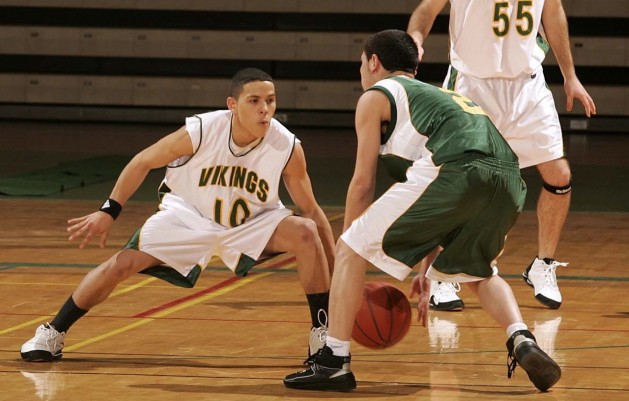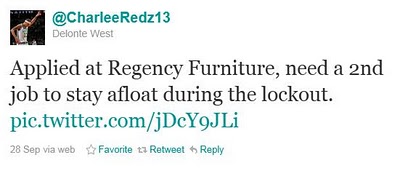Yesterday’s Annotated Smartphone Bathroom Reader highlighted a fantastic piece by Zach Lowe that explained how the Toronto Raptors front office is using missile-tracking camera technology to improve on defense. In previous articles Lowe and Tom Haberstroh detailed some of the information learned from this technology, but it is clear now those reveals were mostly cosmetic compared to how the Raptors are using the cameras. The Raptors have programmed an entire “Ghost” defense to simulate how their defense should have reacted on any given play, and by comparing how the “Ghosts” move with how the actual Raptors move, they are (in theory) better able to understand and teach defense.

Lowe’s column on the Raptors use of SportsVu cameras was actually a two-parter, and the next day he answered the two most common responses he got to the article:
“1. Holy cow! The Raptors are way ahead of (Insert Team X) in gleaning useful data from the SportVU camera systems.”
“2. If Toronto’s front office is so savvy, and so determined to combine traditional “eye test” analysis with the most advanced data available, why are they still a mediocre team? And why did they trade for Rudy Gay, an inefficient player whom a new, analytics-savvy front office in Memphis dumped within months of its ascension?”
Those are certainly interesting thoughts, versions of which also crossed my mind as I read the article. My biggest question, however, was left unasked and unanswered: why the hell did the Toronto Raptors release so much information to Lowe? It is one thing to talk to the Raptors organization about their use of analytics, but it is quite another for the organization to supply him with actual animations from the system and walk him through understanding them.

Writing over at The Wages of Wins Journal, Devin Dignam asserts that the release is no big deal:
“What the Raptors stats guys did with the coordinate data — as awesome as it is — is blatantly obvious and the first thing that comes to everyone’s mind when they hear about SportVU. The trick is to actually build a program that will turn the data into something usable. Likewise, demonstrating that they’ve created an algorithm to determine ideal defensive position is not going to give very much away, as they have not revealed how the algorithm actually works.”
Now, I am in no position to accurately evaluate how valuable the information the Raptors shared with Lowe is. What I do know is that it is magnitudes more in-depth than any information an NBA front office has ever released about how it uses analytics, and the Raptors provided Lowe with actual visualizations from the program they have written. This is unprecedented territory as far as giving access to a journalist is concerned. After all, it was less than a month ago that Jason Schwartz, backed up by analytics luminaries like Dean Oliver and Daryl Morey, wrote:
“Desperate for any competitive advantage, NBA teams guard their data—and whatever conclusions they draw from it—with about the same paranoia as a government official sitting on bomb codes.”
So, to continue the analogy, why did the Toronto Raptors hand Lowe the nuclear football?
When asked directly, Lowe would only speak in vague, wishy-washy terms. The broader discussion has seemed to settle on three possibilities, which I have ordered by how I perceive their likelihood.
1. The Toronto Raptors revealed so much information because the analytics staff wanted to send a very public job application to the rest of the league.

As Arturo Galletti says in the comment section of the aforementioned article at The Wages of Wins Journal, “They know a change is coming and are making sure that everyone is aware that it wasn’t their fault.” The Raptors aren’t very good this year, and haven’t been very good since Chris Bosh left. With the very possible axing of general manager Bryan Colangelo and a reevaluation of the entire front office coming this offseason, the analytics staff wants the rest of the league—their potential future employers—to know that they are skilled and worthy of hiring.
Galletti points to the discussion of shot selection near the end of Lowe’s article where you can practically spot people jumping up and down shouting “hire me!” through the screen, and he’s right. Whereas earlier in the article the quoted analytics staff is mostly deferential to the coaching staff, here director of analytics Alex Rucker is much more forceful:
“‘When you ask coaches what’s better between a 28 percent 3-point shot and a 42 percent midrange shot, they’ll say the 42 percent shot,’ Rucker says. ‘And that’s objectively false.’”
Keith Boyarsky, the technical director of analytics, follows with a naked criticism of the coaching staff’s development of talented rookie Jonas Valanciunas, arguing that even when making mistakes he’s still better than the alternative, a viewpoint coach Dwayne Casey strongly disagrees with. But if the rest of the league is laughing at the Raptors shot selection and development of Jonas Valanciunas, perhaps the analytics staff wants to make sure they aren’t the ones holding the bag for the Raptors poor season.
2. The Toronto Raptors revealed so much information to prove to the rest of the league that the front office isn’t filled with idiots.

This is a variation of possibility number one, expanding the protagonists from the analytics staff to the entire front office and advancing a slightly less individually self-interested justification. The fact of the matter is that the Raptors front office is seen as somewhat of a joke around the league. From their terrible re-signing and handling of Andrea Bargnani to their widely panned decision to give up useful roster pieces for volume gunner Rudy Gay (to pair next to volume gunner DeMar DeRozan), the Raptors just aren’t seen as a very smart organization.
Now, of course a better way to prove the Raptors are a competent organization would be to, you know, be competent. Salary capped out for the forseeable future and with little star talent on the roster however, it isn’t likely that the Raptors will be able to show competency through their play on the floor any time soon. The next best thing I suppose is to give the rest of the league a peak behind the curtain. Not the most ego-less move perhaps, but effective nonetheless.
3. The Toronto Raptors revealed so much information to try and shame coach Dwayne Casey to act upon it.

When I watch movies or TV shows, I find it difficult to sit still during awkward moments. When I can foresee an awkward plot ahead, I get physically uncomfortable and find it difficult to watch. I don’t exactly understand why my body does this, but that’s neither here nor there. What I do know is that I felt a similar feeling at times while reading this article. Despite Lowe’s assertion to the contrary—“But let’s not exaggerate: This isn’t Moneyball, with people at each other’s throats and folks threatening to quit their jobs”—the tension between the Raptors coaching staff and the front office is palpable.
Writing in the Toronto Star, Cathal Kelly asked Dwayne Casey for his reaction to the article, making it clear that Casey had no involvement in deciding to release this information.
“Three animations accompany the text. When told that on Tuesday afternoon, Raptors coach Dwane Casey reared back in surprise.
‘What?’ Casey said. ‘Not the actual thing?’
The actual thing.
Casey was left briefly speechless. It is difficult to credit that the people guarding the team vaults are also doing guided tours.”
Indeed, I have never seen a coach so forcefully criticized on the record by somebody in his own organization that wasn’t the general manager or owner, and usually a firing was quick behind. Just three weeks ago I wrote about my frustration with 76ers director of analytics Aaron Barzilai’s acquiescence to coach Doug Collins’ wrongness, and yet here we have multiple members of the Raptors analytics staff openly questioning Casey’s decisionmaking in a national publication.
***
Whatever the reason the Raptors cooperated with Lowe’s reporting, it is clear that the most important battle over analytics isn’t taking place in the media or at conferences, but within NBA front offices themselves. Despite Dwayne Casey, Doug Collins and other coaches intransigence, I suspect that in the end—as it almost always does—more and better information will win out. In the meantime, I suggest Rucker and Boyarsky take a look at this job posting. Seems safe to say they have “experience with varied programming languages”, though whether or not they exhibit “ONE TEAM PHILOSOPHY of PASSION, ACCOUNTABILITY, CUSTOMER FOCUS, TEAMWORK” is an open question.

